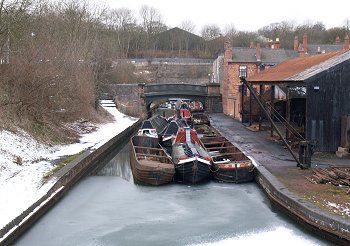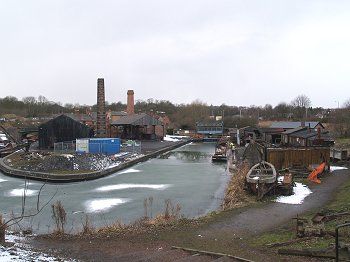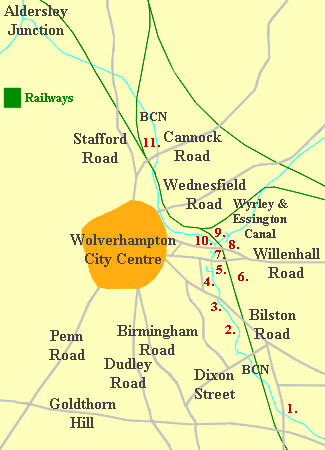|
The Black
Country owes its rapid industrial growth to the complex
network of canals that criss-cross the region. The canal
network rapidly grew in the late 18th century and
brought many benefits to the towns and cities that it
served, throughout the country. The roads of the day
were poor and badly maintained, and journey times were
long and uncertain due to the vagaries of the roads and
the weather. Heavy goods were difficult to transport and
the cost of transportation was very high.
The local area
had a vast mineral wealth with coal, limestone, and iron
ore in abundance. The difficulties of transporting large
quantities of raw materials, even to somewhere as close
as Birmingham were astronomical. Birmingham badly needed
a cheap and reliable source of coal and so the local
canal system was conceived as a way of achieving this. |
|

A winter's day at the Black
Country Living Museum. |
Very large sums of money were
required to finance the building of canals, but luckily
there were many local businessmen and traders with
disposable income, who would willingly invest in such
schemes in the hope on getting a large return on their
investment. The canal system
certainly lived up to their expectations. Once the
Birmingham Canal was in operation the cost of Black
Country coal dramatically fell, as large quantities were
mined and transported on the new canals. |
| Vast quantities of limestone were
transported from the Dudley and Walsall areas and heavy
industries such as iron and steel began to grow, using
the canal network to bring-in their raw materials and
deliver their finished goods. By 1851 there were no less
than 13 coal merchants based on the canal in
Wolverhampton alone, and large factories sprung-up on
the canal sides. The large quantities of coal, raw
materials, and finished goods that were transported on
the canals at the time, made the canal companies very
wealthy, greatly benefiting their share holders. |
| The population of many of the
local towns rapidly grew thanks to the employment
offered by the new factories, and the cost of some of
the items for sale in the shops fell due to large–scale
manufacturing and ease of transport. A greater variety
of goods could be found in the shops thanks to the
reliable transport on the canal network. The large-scale
textile and garment manufacturers in Derbyshire,
Lancashire and Yorkshire relied on the canals to
transport their goods, which could quickly be delivered
to the Midlands, reducing the cost of clothing, and
increasing the variety that was available in the shops. |

| Another view of
the canal at the Black Country Living
Museum, Dudley. |
|
| The canal network was connected
to sea ports so that manufacturers could easily export
their products and many imported goods were readily
available for the first time. The falling cost of coal
reduced people’s heating bills and the large amount of
raw materials and goods that were transported allowed
traders in the local towns to easily provide the
expanding population with all of their needs.
Although principally used to
transport goods, canals were also used to transport
people, until the arrival of the railways. Passenger
boats originally took 4 hours to travel from
Wolverhampton to Birmingham, although the travelling
time was reduced to 3 hours when Telford’s new main line
opened.
For many years canals were the vital arteries of the
midlands and remained so until they were overtaken by
modern forms of transport and better roads. It is now
hard to imagine just what the canals were like in their
heyday. Today they are tranquil places for relaxation
and enjoyment, but two hundred years ago it was a very
different story. |

| A map showing the
area that will be covered in the description
of the industries that grew-up alongside the
canal. |
|
The approximate location of some of
the industries to be described:
|
1. |
Mars Iron Works |
|
2. |
Bayliss Jones &
Bayliss |
|
3. |
Eagle Works |
|
4. |
Commercial Road
wharves and factories |
|
5. |
Shrubbery Iron
Works |
|
6. |
Chillington
Iron Works |
|
7. |
Lower Walsall
Street Works, Minerva Works etc. opposite. |
|
8. |
Beaver Works |
|
9. |
Osier Bed Iron
Works |
|
10. |
Crane Foundry,
Horseley Chemical Works, T & C Clark etc. |
|
11. |
Crown
Galvanising Works, Ceres Manure Works. |
|
|
Canals are a very personal thing
for me and it is a pleasure to write about them. I
grew-up in the Black Country and started to walk along
the canals and explore them from the age of nine or ten.
I have been doing so ever since, and will continue to do
so as long as I can.
I was inspired to produce this section thanks to the
research that was carried out in the 1970s by the late
Ron Eason. He had a great interest in the local canals
and the early factories that grew alongside them.
References for this
section:
Black Country Canals, Paul Collins, Sutton
Publishing, 2001.
A History of Wolverhampton, Chris Upton, Phillimore &
Co. Ltd., 1998.
Guide to the Iron Trade of Great Britain, Samuel
Griffiths, London, 1873.
The Horseley Fields Canal and Railway Junction, Austin
Moseley.
ECC Institute News, Autumn 1954.
Staffordshire Industrial Archaeology Society Journal,
Vol. 3, 1972.
The North Western Railway Guide, 1861
Wolverhampton Chronicle - various articles.
Wolverhampton Red Books and local trade directories. |
 |
Return to the Canals
and Industry Menu |
|